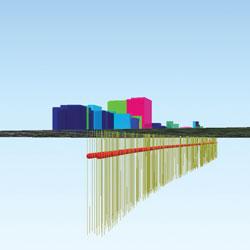
The Department of Engineering’s Centre for Smart Infrastructure and Construction (CSIC) is building on advances in sensing technology to learn everything possible about a city’s infrastructure. This includes tunnels, roads, bridges, sewers and power supplies, in order to maintain a city and optimise its use for the future. CSIC, an Innovation and Knowledge Centre jointly funded by the Engineering and Physical Sciences Research Council and Innovate UK, works to bridge the gap between University research and industry in the area of ‘smart’ infrastructure.
The infrastructure of the city of London and the rest of the UK is in generally in good health, however, literal and figurative cracks are rapidly appearing. The London Infrastructure Plan 2050, launched in 2014, states the capital should accommodate growth until 2025, within existing boundaries. It estimates a £1.3 trillion investment in the city’s infrastructure is required between 2014 and 2050, an amount more than half of the UK’s current GDP.
One of the CSIC projects maximising the value of existing infrastructure is looking to extract the heat from the London Underground to heat and cool the buildings above it. Researchers in Dr Ruchi Choudhary’s group in the Department of Engineering are modelling the amount of heat that can be extracted from the Tube, how many buildings can be heated or cooled, and how that might be affected by future climate change. These geothermal systems offer a potential energy-efficient cooling solution compared with energy-intensive conventional cooling.
Click here to read the full article.
Image credit: Geothermal modelling by Dr Ruchi Choudhary

